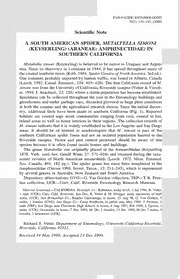
A South American spider, Metaltella simoni (Keyserling) (Araneae: Amphinectidae) in southern California PDF
Preview A South American spider, Metaltella simoni (Keyserling) (Araneae: Amphinectidae) in southern California
PAN-PACIFIC ENTOMOLOGIST 76(2): 134-135, (2000) Scientific Note A SOUTH AMERICAN SPIDER, METALTELLA SIMONI (KEYSERLING) (ARANEAE: AMPHINECTIDAE) IN SOUTHERN CALIFORNIA Metaltella simoni (Keyserling) is believed to be native to Uruguay and Argen¬ tina. Since its discovery in Louisiana in 1944, it has spread throughout many of the coastal southern states (Roth. 1994. Spider Genera of North America, 3rd ed.). One transient, probably imported by human traffic, was found in Alberta, Canada (Leech. 1992. Canad. Entomol., 124: 419-420). The first California record of M. simoni was from the University of California, Riverside campus (Vetter & Vissch- er. 1994. J. Arachnol., 22: 256) where a stable population has become established. Specimens can be collected throughout the year in the Entomology buildings and greenhouses and under garbage cans, discarded plywood or large plant containers at both the campus and the agricultural research station. Since the initial discov¬ ery, additional finds have been made in southern California (Fig. 1). Reported habitats are coastal sage scrub communities ranging from cool, coastal to hot, inland areas as well as home interiors in these regions. The collection records of M. simoni indicate that it is widely established in the Los Angeles and San Diego areas. It should be of interest to arachnologists that M. simoni is part of the southern Californian spider fauna and not an isolated population limited to the Riverside campus. Vector and pest control personnel should be aware of this species because it is often found inside homes and buildings. The genus Metaltella was originally placed in the Amaurobiidae (Keyserling 1878. Verh. zool.-bot. Gesell Wien, 27: 571—624) and retained during the taxo¬ nomic revision of North American amaurobiids (Leech. 1972. Mem. Entomol. Soc. Canada, #84, 182 pp.). The spider genus has since been transferred to the Amphinectidae (Davies 1998. Invert. Taxon., 12: 211-243), which is represented by several genera in Australia, New Zealand and South America. Depository abbreviations: GVG—G. Van Gordon collection, TRP—T. R. Pren¬ tice collection, UCR—Univ. Calif. Riverside Entomology Research Museum. Material Examined.—CALIFORNIA. Riverside Co.: Rubidoux, under brick, 2 Jul 1996, R. Vetter, 1 male (UCR); Univ. Calif. Riverside, Jan-Dee, R. Vetter & M. Metzger, many specimens of both sexes, (UCR). San Bernardino Co.: Rancho Cucamonga, in house, 23 Aug 98, G. Van Gordon, 3 males, 2 females (GVG). San Diego Co.: Camp Pendleton, in pitfall trap, May 1996, T. Prentice, 1 male (TRP); San Diego near Claremont High School, in house, 4 Aug 1997, Feb 1999, J. Carson, 2 males (UCR). Oceanside, in house, 7 Nov 1999, M. Orr, 2 females; 13 Dec 1999, M Orr, 2 males, 9 females, 2 immatures (UCR). Richard S. Vetter, Department of Entomology, University California Riverside, Riverside, California 92521. Received 19 May 1999; Accepted 23 Dec 1999. 2000 SCIENTIFIC NOTE 135 Figure 1. Collection sites of Metaltella simoni in southern California. Scale bar = 50 km.
